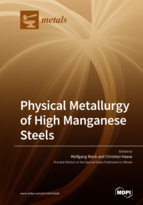Physical Metallurgy of High Manganese Steels
A special issue of Metals (ISSN 2075-4701).
Deadline for manuscript submissions: closed (15 June 2019) | Viewed by 64005
Special Issue Editors
Interests: Materials design, material characterization, materials processing and application, advanced high-strength steels, integrated computational materials engineering
Interests: Materials design, material characterization, materials processing and application, advanced high-strength steels, high-entropy-alloys, integrated computational materials engineering, additive manufacturing
Special Issue Information
Dear Colleagues,
High manganese steels (HMnS) represent a highly fascinating class of alloys within the field of advanced high strength steels. During the last decades, HMnS have gained a lot of attention in both academic and industrial research, mainly due to their outstanding mechanical properties. Therefore, potential fields of industrial application supposedly extend from chassis components in the automotive industry over equipment for low-temperature applications to forgings with alternative process routes. Usually, these steels contain manganese contents well above 3 mass%, along with significant alloying with carbon and aluminium.
The plasticity of HMnS is strongly influenced by their low stacking fault energy. Consequently, the low dynamic recovery rate in combination with the activation of additional deformation mechanisms, i.e., twinning-induced plasticity (TWIP), transformation-induced plasticity (TRIP), and microband-induced plasticity (MBIP), promote high work-hardenability. That results in a combination of high ultimate tensile strength (often above 1 GPa) and high uniform elongation (often above 50%). In order to take full advantage of the potential of HMnS, a description of these mechanisms in predictive, physics-based models is required. However, such descriptions constitute a formidable scientific challenge due to the microstructural modifications at various length scales, as well as complex chemical interactions.
The processing of HMnS requires careful consideration of solidification conditions in order to minimize segregation and control precipitation and microstructure development. The further fabrication via rolling, annealing, cutting, and machining needs to be adopted to the specific material behaviour.
Careful review of the related literature at present revealed that there is still a severe need to better understand the physical metallurgical mechanisms of HMnS. Relevant aspects include but are not restricted to microstructure evolution during deformation and annealing, the role of interfaces, hydrogen embrittlement and management, advanced processing techniques, and multi-scale strain-hardening engineering. Both advanced experimental as well as numerical approaches, including first-principle calculations, are necessary for an increased understanding and future development of HMnS. Comprehensive fundamental research on these topics often necessitates interdisciplinary collaboration of materials scientists, physicists, chemists, and engineers.
It is my pleasure to invite you to submit original contributions to this Special Issue that may take into account any of the materials aspects mentioned above.
Prof. Dr. Wolfgang Bleck
Dr. Christian Haase
Guest Editors
Manuscript Submission Information
Manuscripts should be submitted online at www.mdpi.com by registering and logging in to this website. Once you are registered, click here to go to the submission form. Manuscripts can be submitted until the deadline. All submissions that pass pre-check are peer-reviewed. Accepted papers will be published continuously in the journal (as soon as accepted) and will be listed together on the special issue website. Research articles, review articles as well as short communications are invited. For planned papers, a title and short abstract (about 100 words) can be sent to the Editorial Office for announcement on this website.
Submitted manuscripts should not have been published previously, nor be under consideration for publication elsewhere (except conference proceedings papers). All manuscripts are thoroughly refereed through a single-blind peer-review process. A guide for authors and other relevant information for submission of manuscripts is available on the Instructions for Authors page. Metals is an international peer-reviewed open access monthly journal published by MDPI.
Please visit the Instructions for Authors page before submitting a manuscript. The Article Processing Charge (APC) for publication in this open access journal is 2600 CHF (Swiss Francs). Submitted papers should be well formatted and use good English. Authors may use MDPI's English editing service prior to publication or during author revisions.
Keywords
- Twinning-induced plasticity (TWIP)
- Transformation-induced plasticity (TRIP)
- Slipband refinement-/microband-induced plasticity (SRIP/MBIP)
- Advanced high strength steels
- Mechanical properties
- Strain hardening
- Microstructure
- Interfaces
- Thermodynamics
- First-principles calculations
- Computational materials science







